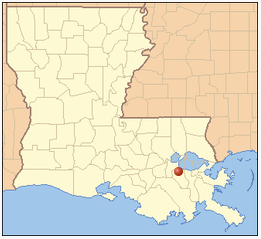| Home | Search | Emissions | Pollutants | About the Database |

Valero (26003), Norco
LDEQ Accident Report
| Accident # | 153767 |
| State Police # | 14-00639 |
| Accident Date | 2014-02-09 |
| Report Date | 2014-02-14 |
| Follow-up Date | 2014-04-10 |
| Follow-up: | Yes |
Pollutants Released
| Pollutant | Duration | Point Source | Greenhouse Gas | Criteria Pollutant | Ozone forming chemical | Amount of Release |
| Sulfur Dioxide | 13h 30m | SMR 1 Heater No. 2, 2005-8 (H001 1st Stage Charge Heater), 2005-9 (H002 2nd Stage Charge Heater), 2005-10 (H003 1st Fractionator Charge Heater), 94-GDU (Low SUlfur Gasoline Unit Heater), 2005-1 (crude Heater F-72-704), 2005-2 (Vacuum Heater F-52-02) | NO | YES | NO | 9,923.0 pounds |
| Hydrogen Sulfide | 13h 30m | SMR 1 Heater No. 2, 2005-8 (H001 1st Stage Charge Heater), 2005-9 (H002 2nd Stage Charge Heater), 2005-10 (H003 1st Fractionator Charge Heater), 94-GDU (Low SUlfur Gasoline Unit Heater), 2005-1 (crude Heater F-72-704), 2005-2 (Vacuum Heater F-52-02) | NO | NO | NO | 25.8 pounds |
Accident Classified As: Reportable Quantity
Cause of Problem: Process Upset
On Febuary 9, 2014, at approximately 18:44 hrs, the lean amine return pump (P-16-204A) tripped offline unexpectedly due to high temperature, which led to flooding of the regenerator column and subsequent downstream amine acid has (AAG) knockout vessels. The AAG knockout vessels reached full capacity, which caused the sulfur recovery units (SRUs) to trip offline. Consequently, we were unable to regenerate our amine used for scrubbing sulfur from refinery fuel gas. As this fuel gas was burned in various process heaters within the refinery, the sulfur was converted and emitted to the atmosphere as SO2. Furthermore, as we recovered from the incident, elevated SO2 emissions were observed during the subsequent startup of the 1600 SRU.
Discharge Preventable - No
The initial loss of pump P-16-204A is not considered reasonably preventable. However, an improved operational response to the pump failure may have reduced emissions, such that an RQ would not have been exceeded.
Notes/Remedial Actions
Emissions were minimized by reducing unit throughputs until the SRUs could be restarted. Air monitoring was conducted in the downstream wind direction with no detected SO2 or H2S readings by the handheld monitor. The procedures/measures adopted to prevent recurrence of this accident are two-fold: 1. Review this incident with affected personnel focusing on shutting down the unit when discharge flow cannot be reestablished in a timely manner and consideration for the response time available in lost flow situations (Completed -- 03/12/2014). 2. Develop "what if" scenarios for employees to use (Completed -- 03/01/2014). Hydrogen Sulfide emissions were calculated assuming a 99.5% conversion of SO2 to H2S in process heaters and excluding H2S emissions resulting from Sulfur Recovery Units which were less than permitted H2S emissions for the accident.

Connect With Us: